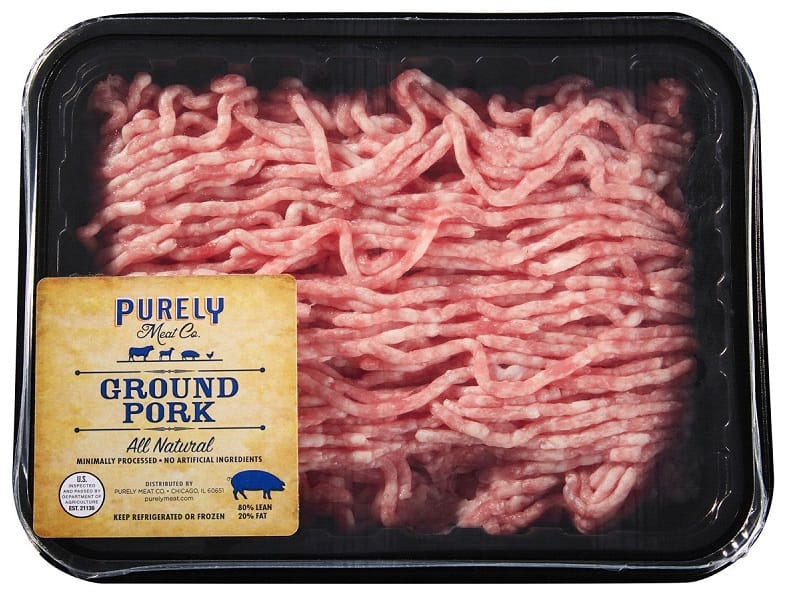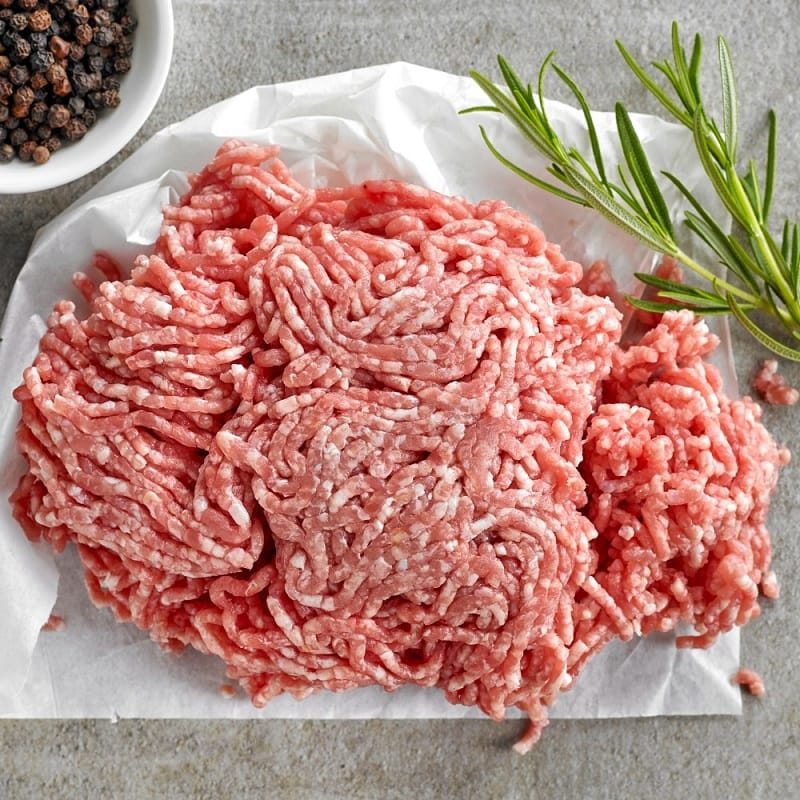Choosing the right meat is essential when preparing some of our favorite dishes. Two of the most popular options for cooks all around the world are ground beef and ground pork. While both choices can be delicious, there are a few key differences to remember before deciding which one to use. Ground beef is known for having a richer flavor that lends itself well to certain dishes, while ground pork is often used in recipes that require a slightly sweeter taste. Additionally, these two meats’ nutritional profiles differ in fat and protein content.
Let’s explore some of the additional nuances of these two popular meats so that you can make a more informed decision next time you’re facing the ground beef vs ground pork conundrum.
What is Ground Beef

Ground beef is beef that is ground or finely chopped into smaller pieces. It is made from various cuts of beef, including chuck, sirloin, and round. It is typically sold in packages and labeled according to the fat content, such as “80/20” meaning that 80% of the product is lean meat, and 20% is fat.
Ground beef can be used in many recipes, from meatloaf to tacos to burgers. It is a very versatile ingredient that can be used in various dishes. It can also be a key component of casseroles, soups, stews, and chili.
Ground beef is a great option for those looking for an inexpensive source of protein. It is also a great way to stretch your food budget and make a meal go further. Being able to buy in bulk can often help you save money in the long run.
Ground beef is an excellent option for busy weeknights, as it is relatively quick to cook and can be used in various ways. And best of all, it’s a family favorite that everyone will enjoy!
What is Ground Pork?

Ground pork is a type of ground meat that is made from pork. It is a popular ingredient in various dishes, from stews to casseroles to tacos. It is a versatile ingredient in various dishes, from breakfast to dinner.
Ground pork is made by grinding the meat from pork shoulders, bellies, hams, and other cuts of pork. It can be purchased in both raw and cooked form. Raw ground pork is typically pink, while cooked ground pork is light brown.
Ground pork is often used to replace ground turkey or beef in recipes. It has a mild flavor and a tender texture, making it a great choice for dishes requiring a lighter and more delicate flavor. It is also lower in fat and calories than ground beef.
Ground pork is an excellent source of protein, B vitamins, and minerals source. It is also a good source of iron, zinc, and selenium. Eating ground pork regularly can help to support a healthy immune system, as it is a good source of Vitamin B6 and magnesium.
Ground pork is a versatile ingredient used in many different dishes. It can be used in tacos, casseroles, stews, soups, and pasta dishes. It is also a great choice for making burgers and meatloaf.
Ground Pork and Ground Beef: The Similarities
These ingredients are incredibly versatile and can be used in various dishes, from tacos to burgers and casseroles. But what are the similarities between the two? Let’s take a closer look.
First, ground pork and beef are high in protein and low in fat. This makes them ideal for anyone looking to include lean meats in their diet. They both also contain essential vitamins and minerals, such as iron, zinc, and B vitamins. While beef may provide slightly more protein, pork typically contains more B vitamins essential for energy production.
Second, both ground pork and ground beef are easy to cook. Ground pork is especially easy to cook, as it takes less time than other pork cuts. In addition, the smaller grain size of ground pork means it absorbs flavors better, making it ideal for flavorful dishes. Ground beef, on the other hand, tends to take longer to cook, but it is a great choice for dishes where you want a more intense flavor.
Finally, both ground pork and ground beef are incredibly versatile. Ground pork can be used as a base for tacos, as a filling for empanadas, or as a topping for pizza and salads. Ground beef, on the other hand, can be used in everything from burgers to chili and casseroles. No matter what dish you’re cooking, you can be sure that ground pork and beef will provide you with a delicious and nutritious meal.
Ground Pork vs. Ground Beef: The Difference
There are some noteworthy differences in nutrition and taste when it comes to ground pork versus ground beef. Ground pork is a versatile and flavorful meat that tends to be sweeter and milder than ground beef. It is also an excellent source of protein, lower in calories than ground beef, and contains more unsaturated fats, vitamins B1 and B2. However, ground pork has more fat and cholesterol per serving than ground beef, making it a slightly less healthy option.
Choosing good cuts of both meats and using them in appropriate recipes is important to maximize their unique flavors and nutritional profiles.
Appearance
Ground pork and beef can look very similar, but key differences exist. Ground pork is usually slightly lighter in color than ground beef and has a finer texture. It can also have a somewhat reddish hue than beef.
Taste
Ground pork has a more delicate flavor than ground beef. It is generally milder and slightly sweeter. Ground beef, on the other hand, has a bolder, more savory flavor.
Texture
Ground pork tends to be slightly more tender than ground beef. When cooked, it can be moister and slightly more crumbly. Ground beef is firmer and can have a slightly tougher texture.
Cooking Time
Ground pork generally cooks faster than ground beef. Keeping an eye on the cooking time is essential, as ground pork can quickly become overcooked. Ground beef, on the other hand, can take longer to cook since it is firmer.
Ground Pork vs Ground Beef: Shelf Life

When it comes to shelf life ground pork usually has a much longer shelf life than ground beef. Ground pork can last up to two weeks in the refrigerator, while ground beef typically only lasts up to five days. This means ground pork is a better option if you buy it in bulk and store it for longer.
Calories
When it comes to calories, ground beef contains more calories than ground pork. Ground beef has about 200-215 calories per four ounces (113 grams), while ground pork has about 160-175 calories per four ounces (113 grams). However, it is essential to remember that calories are not the only factor to consider when selecting ground meat.
Cholesterol Levels
When it comes to cholesterol, ground pork has more cholesterol than ground beef. Ground pork has about 80-90 milligrams of cholesterol per four ounces (113 grams), while ground beef has about 60-75 milligrams per four ounces (113 grams). Therefore, ground pork may be a better option if you want to reduce your cholesterol levels.
Protein And Potassium
Both ground pork and ground beef are high in protein and potassium. Ground pork contains about 21 grams of protein per four ounces (113 grams), while ground beef contains about 19 grams. Both ground types of meat contain about 400 milligrams of potassium per four ounces (113 grams).
What Is The Sustainability Comparison Between Ground Beef And Ground Pork?
So, which is more sustainable: ground beef or ground pork? The answer, as with many things in life, is “it depends.” If you’re looking for a meat with a lower environmental impact and fewer antibiotics and hormones, ground pork might be the better choice. However, if you’re concerned about animal welfare or simply prefer the taste of beef, ground beef might be the way to go. Ultimately, the most sustainable choice is to consume meat in moderation and to look for products that are produced in a way that aligns with your values.
Which Meat Is A Better Source Of Protein And Potassium?
When it comes to protein, ground beef is the clear winner. It contains more protein than ground pork and is also a great source of iron and B vitamins. Ground pork, on the other hand, is slightly lower in protein but higher in potassium and other minerals. In terms of nutrition, both types of meat are fairly similar.
How Does The Fat Content Of Each Type Of Ground Meat Compare?
When it comes to fat content, there is a significant difference between ground pork and ground beef. Ground beef is higher in fat, containing about 15-20% fat, compared to ground pork, which contains about 5-10% fat. This makes ground pork a healthier choice for those trying to avoid excess fat.
Popularity
In terms of popularity, ground beef is the clear winner. It’s the most commonly used ground meat and is an essential ingredient in many dishes, from burgers to tacos. Ground pork is less popular but still used in sausages and pork burgers.
Cost
Finally, when it comes to cost, ground beef is generally more expensive than ground pork. This is mainly because of the higher fat content in ground beef, which can add to the cost of the product. Ground pork, on the other hand, is usually cheaper, making it a cost-effective alternative.
Read more:
Can You Mix Ground Pork and Ground Beef?

The answer to this question is yes. Mixing ground pork and ground beef is a great way to combine the flavors and textures of both meats. It is important to ensure that the different meats are cooked evenly and that no raw pork or beef is left in the dish.
When mixing the two types of ground meats, it is important to consider the texture of the meat. If the surface of the pork is too coarse, it might not mix well with the beef. It is also important to ensure that the different meats are cooked evenly and that no raw pork or beef is left in the dish.
There are many different options for cooking with ground pork and ground beef. For example, you can make burgers, meatloaf, meatballs, and tacos with the two meats combined. You can also use them to make chili, shepherd’s pie, and other hearty dishes. The possibilities are truly endless.
Combining ground pork and beef can benefit those looking for a healthier option. Since pork is fattier than beef, the dish’s fat content will be lessened when both ground meats are combined. This can be a great way to reduce the amount of saturated fat in a dish without sacrificing flavor.
What Are The Health Benefits And Risks Of Consuming Ground Beef?
Health benefits of consuming ground beef
1. Rich in protein
One of the most significant health benefits of consuming ground beef is that it is a great source of protein. Protein is essential for the growth and repair of our muscles, tissues, and cells. It also helps in the production of enzymes, hormones, and antibodies.
2. Source of essential vitamins and minerals
Ground beef is a rich source of essential vitamins and minerals such as iron, zinc, and vitamin B12. Iron is essential for the formation of red blood cells, while zinc is crucial for immunity and wound healing. Vitamin B12 is essential for the proper functioning of the nervous system.
3. Promotes satiety
Ground beef is a filling food, which means it can help you feel full for longer. This can be beneficial for weight management as it can help prevent overeating and snacking between meals.
Risks of consuming ground beef
1. High in saturated fat
Ground beef is high in saturated fat, which can increase your risk of heart disease and other health problems. Consuming too much-saturated fat can raise cholesterol levels and lead to plaque buildup in your arteries.
2. Risk of foodborne illness
Ground beef is often associated with foodborne illnesses such as E. Coli and Salmonella. These bacteria can cause severe symptoms such as diarrhea, vomiting, and fever. It is important to cook ground beef thoroughly to kill any bacteria that may be present.
3. Environmental concerns
The production of beef has a significant impact on the environment. It requires a lot of resources, such as water, land, and feed, which can lead to deforestation, water pollution, and greenhouse gas emissions.
What Are The Health Benefits And Risks Of Consuming Ground Pork?
Health Benefits of Ground Pork
Protein
Ground pork is a rich source of protein, which is essential for the growth and repair of our body tissues. A 100-gram serving of ground pork provides around 25.7 grams of protein, almost half the recommended daily allowance for an average adult.
Vitamins and Minerals
Ground pork is also rich in essential vitamins and minerals, including vitamin B12, zinc, selenium, and iron. These nutrients are important for maintaining good health and preventing various diseases.
Low Carbohydrates
Ground pork is naturally low in carbohydrates, making it a great choice for people on a low-carb or keto diet. This means that it won’t spike your blood sugar levels, making it a good choice for people with diabetes.
Risks of Consuming Ground Pork
Contamination
One of the biggest risks associated with consuming ground pork is contamination with harmful bacteria such as Salmonella, E. coli, and Listeria. These bacteria can cause food poisoning and other serious health problems. To minimize the risk of contamination, it’s essential to cook ground pork thoroughly and practice proper hygiene in the kitchen.
High in Saturated Fat
Ground pork is high in saturated fat, which can contribute to various health problems such as heart disease, high cholesterol, and stroke. If you consume ground pork regularly, it’s essential to balance it with a healthy diet and exercise to maintain good health.
Can Ground Pork Replace Ground Beef?
When it comes to the question of whether ground pork can replace ground beef, the answer is a resounding yes! Ground pork is a great alternative to its beef counterpart and can be used in a variety of different recipes.
Ground pork is much leaner than ground beef, making it a healthier choice. It has a slightly milder flavor than beef, which can be great for those looking for a mild flavor. Ground pork is also much more affordable than beef, making it a great option if you’re looking to save money.
Ground pork is incredibly versatile and can be used in various dishes. Ground pork can be used in tacos, burritos, chili, and even ground pork burgers. It’s also great in meatballs, meatloaf, and even lasagna. The possibilities are endless!
When cooking ground pork, you’ll want to cook it thoroughly to ensure it is safe to eat. Use a meat thermometer to check that the internal temperature of the pork reaches at least 160 degrees Fahrenheit before serving. It’s also important to ensure you season the pork well before cooking, as this will help bring out the flavor.
Which Ground Meat Is Healthiest?

Ground pork and ground beef are popular when cooking meat-based dishes. However, when it comes to finding the healthiest option between the two, it can be a bit confusing. Ground pork is considered a versatile meat that is lower in calories and an excellent source of protein. It tends to have higher protein levels, unsaturated fats, and vitamins B1 and B2, making it a healthier option than ground beef. Pork also has a sweeter, milder flavor compared to beef.
On the other hand, ground beef has more iron, zinc, and vitamin E. It is essential to remember that pork has more fat and cholesterol than beef, so it’s important to keep that in moderation. Overall, it’s all about balance and moderation when choosing what ground meat to use in your meals.
What Are Cuts Of Beef Usually Used For Making Ground Meat?
According to factual data, chuck cuts, which come from the upper part of the cow around the neck to the fifth rib, are one of the most widely used cuts. Chuck steak, in particular, is the most common cut of beef used in burger blends. Ground round and ground sirloin are also popular options for making ground beef. The leanness of the meat varies depending on the type of cut used.
Regular ground beef, made up of different trimmings and cuts around the cow’s body, typically contains the highest fat content, while ground sirloin is the leanest. Various options are available when making ground meat, but these three cuts are often the go-to for many butchers and grocery stores.
Does One Type Of Meat Offer More Versatility Than The Other When It Comes To Cooking Applications?
Ground pork and ground beef have unique characteristics in cooking applications. While ground pork is a versatile meat that is less in calories and an excellent source of protein, ground beef tends to have a juicier taste that is perfect for burgers and meatloaves. Pork also has a sweeter, milder flavor than beef, making it a healthier option for those conscious of their calorie intake. One might think that a lean cut, such as tenderloin, would be the best choice, but ground pork has more protein than any other type of ground meat.
However, when it comes to cost and availability, ground beef is often preferred due to its lower cost and wider availability in grocery stores. In conclusion, both types of meat offer unique benefits and can be used interchangeably in many dishes, but ultimately it comes down to personal preference and specific cooking needs.
Ground Pork vs. Ground Beef – FAQs
Are There Any Unique Taste Profiles That Can Be Achieved With Either Beef Or Pork When Preparing A Dish With These Kinds Of Meats?
Regarding preparing delicious meat dishes, beef and pork offer unique flavor profiles that can be achieved with different cooking methods and ingredients.
- Beef tends to have a rich, bold flavor that pairs well with bolder spices and herbs like rosemary and garlic. It also has a natural umami flavor that can be enhanced with savory ingredients like soy sauce and Worcestershire sauce.
- Pork, conversely, has a slightly sweeter and milder flavor that can be complemented with spices like paprika and cumin. It also pairs well with sweet, tangy sauces like barbecue and honey mustard.
Both meats can be cooked in various ways, such as grilling, roasting, or slow-cooking, to achieve different taste profiles and textures. Ultimately, the flavor of the meat will depend on the preparation method and the ingredients used, allowing for endless culinary possibilities.
Which Meat Is Better For Making Burgers?
When making the perfect burger, choosing the right meat is key. While beef tends to be the most popular choice, there are a variety of cuts to consider. The top choices are Chuck, round, and brisket due to their high-fat content and rich flavor. Chuck, in particular, is commonly cited as the best meat for burgers, thanks to its 80/20 fat ratio.
However, sirloin and tri-tip can also make great burgers, especially when supplemented with another cut to add moisture. Don’t feel restricted to beef; pork, chicken, or turkey can also be used. To ensure a tasty and juicy burger, keep the meat cold during preparation and choose a quality cut with plenty of marbling.
What Are Some Common Fillers Found In Ground Beef?
When it comes to ground beef, fillers are commonly added to stretch the meat and lower the cost. Some of the most common fillers include bread crumbs, soy protein, and textured vegetable protein. Other options include beans or rice for taco meat, oatmeal, and breadcrumbs for hamburgers and meatloaf. A good rule of thumb is to add one cup of filler for every pound of meat. While fillers can help reduce the cost, they can also affect the meat’s nutritional value and overall taste. It’s important to read labels and be aware of what’s in the ground beef you purchase.
How Much Ground Beef Or Ground Pork Should One Use Per Person For A Meal?

A general guideline is to use half a pound of ground beef per person for a main dish, such as burgers or tacos. For spaghetti, use four ounces; for tacos, use five ounces. If the beef is part of a bigger dish, like pasta or curry, plan for four to six ounces per person.
When cooking ground pork for a meal, consider a few things. The general rule of thumb is to plan on serving 1/4 pound of cooked ground pork per person. However, if the meal is the main feature of the dinner and is only paired with a few side dishes, it might be best to serve closer to 1/2 pound per person. Having some extra on hand for big eaters, such as teenagers or athletes, is always a good idea. Using lean or extra lean ground pork, you’ll find that 1 pound will yield approximately four servings.
It’s always best to estimate a little extra to accommodate big eaters or those who may want seconds. Using these simple guidelines, anyone can easily calculate the right amount of ground beef or pork for their next delicious meal.
Conclusion
Ultimately, the choice between ground beef vs ground pork is personal. Ground beef may be the right choice if you want a richer, more beefy flavor. Ground pork may be the better option if you’re looking for a lighter, more subtle flavor. Ultimately, it comes down to your taste preferences and nutrition goals.
References:
- https://www.fsis.usda.gov/food-safety/safe-food-handling-and-preparation/meat/ground-beef-and-food-safety
- https://www.masterclass.com/articles/ground-chuck-vs-ground-beef
- https://www.fsis.usda.gov/PDF/Beef_Veal_Nutrition_Facts.pdf

Hey readers! Chip Holland here, and I’m a Manager of this website. My passion for writing about it only matches my passion for BBQ. Follow my blog for mouth-watering recipes, tips, and tricks for the perfect smoke, grill, and BBQ. I’m sure you won’t be disappointed!
